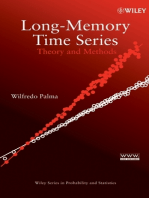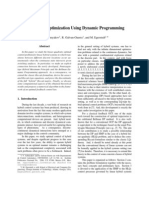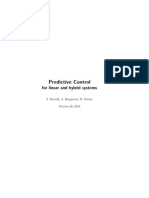Exercise Dynamic Programming
Uploaded by
Santiago Garrido BullónExercise Dynamic Programming
Uploaded by
Santiago Garrido BullónNumerical Optimal Control, August 2014
Exercise 5: Dynamic programming
Joel Andersson Joris Gillis Greg Horn Rien Quirynen Moritz Diehl
University of Freiburg – IMTEK, August 5th, 2014
Dynamic programming for a two-state OCP
Dynamic programming and its continuous time counterpart – the Hamilton-Jacobi-Bellman
equation – can be used to calculate the global solution of an optimal control problem. Unfor-
tunately they suffer from Bellman’s so-called “curse-of-dimensionality”, meaning that they get
exponentionally expensive with the number of states and control. In practice, they can be used
for systems with 3-4 differential states or systems that have special properties.
Here we shall consider a simple OCP with two states (x1 , x2 ) and one control (u):
Z T
minimize x1 (t)2 + x2 (t)2 + u(t)2 dt
x,u 0
(1)
subject to ẋ1 = (1 − x22 ) x1 − x2 + u, x1 (0) = 0
ẋ2 = x1 , x2 (0) = 1
−1 ≤ x1 (t) ≤ 1, −1 ≤ x2 (t) ≤ 1, −1 ≤ u(t) ≤ 1,
with T = 10.
To be able to solve the problem using dynamic programming, we parameterize the control
trajectory into N = 20 piecewise constant intervals. On each interval, we then take NK steps
of a RK4 integrator in order to get a discrete-time OCP of the form:
N −1
(k) (k)
X
minimize F0 (x1 , x2 , u(k) )
x,u
k=0
(k+1) (k) (k) (0) (2)
subject to x1 = F1 (x1 , x2 , u(k) ), k = 0, . . . , N − 1, x1 = 0
(k+1) (k) (k) (0)
x2 = F2 (x1 , x2 , u(k) ), k = 0, . . . , N − 1, x2 = 1
(k) (k)
−1 ≤ x1 ≤ 1, −1 ≤ x2 ≤ 1, −1 ≤ u(k) ≤ 1 ∀k.
Tasks:
5.1 On the course webpage and on Gist1 , you will find an incomplete implementation of
dynamic programming for problem (2). Add the missing calculation of the cost-to-go
function to get the script working.
5.2 Add the additional end-point constraint x1 (T ) = −0.5 and x2 (T ) = −0.5. How does the
solution change?
1
https://gist.github.com/jaeandersson/e37e796e094b3c6cad9e
You might also like
- Calibration or Quality Assurance - Endress+HauserNo ratings yetCalibration or Quality Assurance - Endress+Hauser19 pages
- 1 Optimal Control: 1.1 Problem DefinitionNo ratings yet1 Optimal Control: 1.1 Problem Definition8 pages
- Adaptive DP For Discrete Time LQR Optimal Tracking Control Problems With Unknown DynamicsNo ratings yetAdaptive DP For Discrete Time LQR Optimal Tracking Control Problems With Unknown Dynamics6 pages
- An Introduction To Optimal Control TheoryNo ratings yetAn Introduction To Optimal Control Theory279 pages
- Dynamic Programming and Optimal Control ScriptNo ratings yetDynamic Programming and Optimal Control Script58 pages
- Dynamic Programming and Linear Quadratic (LQ) Control (Discrete-Time and Continuous Time Cases)No ratings yetDynamic Programming and Linear Quadratic (LQ) Control (Discrete-Time and Continuous Time Cases)53 pages
- Dynamic_Programming_and_Optimal_ControlNo ratings yetDynamic_Programming_and_Optimal_Control62 pages
- Minimax Linear Regulator Problems For Positive SystemsNo ratings yetMinimax Linear Regulator Problems For Positive Systems26 pages
- (Ebook) Adaptive Dynamic Programming with Applications in Optimal Control by Derong Liu, Qinglai Wei, Ding Wang, Xiong Yang, Hongliang Li (auth.) ISBN 9783319508139, 9783319508153, 331950813X, 3319508156 2024 Scribd Download100% (9)(Ebook) Adaptive Dynamic Programming with Applications in Optimal Control by Derong Liu, Qinglai Wei, Ding Wang, Xiong Yang, Hongliang Li (auth.) ISBN 9783319508139, 9783319508153, 331950813X, 3319508156 2024 Scribd Download65 pages
- [15] Robust control scheme for a class of uncertain nonlinear systems with completely unknown dynamics using data-driven reinforcement learning methodNo ratings yet[15] Robust control scheme for a class of uncertain nonlinear systems with completely unknown dynamics using data-driven reinforcement learning method34 pages
- Dynamic Programming Online Teaching FOR PRINTNo ratings yetDynamic Programming Online Teaching FOR PRINT44 pages
- Robust Control Barrier Functions For Nonlinear Control Systems With Uncertainty: A Duality-Based ApproachNo ratings yetRobust Control Barrier Functions For Nonlinear Control Systems With Uncertainty: A Duality-Based Approach8 pages
- Fbmmm-742 Applied Optimal Control FINAL (Delivery Date: 05 June 2020)No ratings yetFbmmm-742 Applied Optimal Control FINAL (Delivery Date: 05 June 2020)4 pages
- Adaptive Dynamic Programming With Applications in Optimal Control (PDFDrive)No ratings yetAdaptive Dynamic Programming With Applications in Optimal Control (PDFDrive)609 pages
- Hybrid LQ-Optimization Using Dynamic Programming: V. Azhmyakov, R. Galvan-Guerra, and M. EgerstedtNo ratings yetHybrid LQ-Optimization Using Dynamic Programming: V. Azhmyakov, R. Galvan-Guerra, and M. Egerstedt9 pages
- An Augmented Lagrangian for Optimal Control of DAE Systems: Algorithm and PropertiesNo ratings yetAn Augmented Lagrangian for Optimal Control of DAE Systems: Algorithm and Properties6 pages
- Optimal Control of Differential Systems With Discontinuous Right-Hand SideNo ratings yetOptimal Control of Differential Systems With Discontinuous Right-Hand Side109 pages
- 5.1 Dynamic Programming and The HJB Equation: k+1 K K K KNo ratings yet5.1 Dynamic Programming and The HJB Equation: k+1 K K K K30 pages
- Global Adaptive Dynamic Programming For Continuous-Time Nonlinear SystemsNo ratings yetGlobal Adaptive Dynamic Programming For Continuous-Time Nonlinear Systems13 pages
- Vassilis Sakizlis, Vivek Dua, Stratos PistikopoulosNo ratings yetVassilis Sakizlis, Vivek Dua, Stratos Pistikopoulos34 pages
- Predictive Control: For Linear and Hybrid SystemsNo ratings yetPredictive Control: For Linear and Hybrid Systems458 pages
- PhysRevResearch.5.013122 Physics of networksNo ratings yetPhysRevResearch.5.013122 Physics of networks9 pages
- Stochastic Feedback Controller Design Considering The Dual EffectNo ratings yetStochastic Feedback Controller Design Considering The Dual Effect13 pages
- Student Solutions Manual to Accompany Economic Dynamics in Discrete Time, secondeditionFrom EverandStudent Solutions Manual to Accompany Economic Dynamics in Discrete Time, secondedition4.5/5 (2)
- Mathematics 1St First Order Linear Differential Equations 2Nd Second Order Linear Differential Equations Laplace Fourier Bessel MathematicsFrom EverandMathematics 1St First Order Linear Differential Equations 2Nd Second Order Linear Differential Equations Laplace Fourier Bessel MathematicsNo ratings yet
- Inverse Trigonometric Functions (Trigonometry) Mathematics Question BankFrom EverandInverse Trigonometric Functions (Trigonometry) Mathematics Question BankNo ratings yet
- Lyapunov-Based Methods in Control: Dr. Alexander SchaumNo ratings yetLyapunov-Based Methods in Control: Dr. Alexander Schaum22 pages
- Introduction To Mobile Robotics - Burgard PDFNo ratings yetIntroduction To Mobile Robotics - Burgard PDF745 pages
- The Maximum Principle and Hamilton Jacobi TheoryNo ratings yetThe Maximum Principle and Hamilton Jacobi Theory40 pages
- A Simple Explanation of Why Lagrange Multipliers Works: Andrew Chamberlain, PH.DNo ratings yetA Simple Explanation of Why Lagrange Multipliers Works: Andrew Chamberlain, PH.D13 pages
- Chapter 2 - Burl Optimal Quadratic Control: Islamic University of GazaNo ratings yetChapter 2 - Burl Optimal Quadratic Control: Islamic University of Gaza44 pages
- Lyapunov Stability Theory:: Problem of Motion Stability, Includes Two Methods For Stability Analysis (The SoNo ratings yetLyapunov Stability Theory:: Problem of Motion Stability, Includes Two Methods For Stability Analysis (The So25 pages
- 1 X X X X : Examples: Example 1: Consider The SystemNo ratings yet1 X X X X : Examples: Example 1: Consider The System16 pages
- Metrology and Calibration of Mechatronic Systems - OverviewNo ratings yetMetrology and Calibration of Mechatronic Systems - Overview12 pages
- Comparison of Different DC Motor Positioning Control AlgorithmsNo ratings yetComparison of Different DC Motor Positioning Control Algorithms6 pages
- Thermodynamics and Statistical Mechanics Books0% (1)Thermodynamics and Statistical Mechanics Books3 pages
- CH - CSE2014 - Software Engineering - As Per NAACNo ratings yetCH - CSE2014 - Software Engineering - As Per NAAC10 pages
- Bifurcation Theory and Its Application To Nonlinear Dynamical Phenomena in A N Electrical Power SystemNo ratings yetBifurcation Theory and Its Application To Nonlinear Dynamical Phenomena in A N Electrical Power System8 pages
- B.E Thesis Title Defense: Mandalay Technological UniversityNo ratings yetB.E Thesis Title Defense: Mandalay Technological University14 pages
- Thermodynamics II Assignment 3: C R I H H I R H HNo ratings yetThermodynamics II Assignment 3: C R I H H I R H H2 pages






















































































































